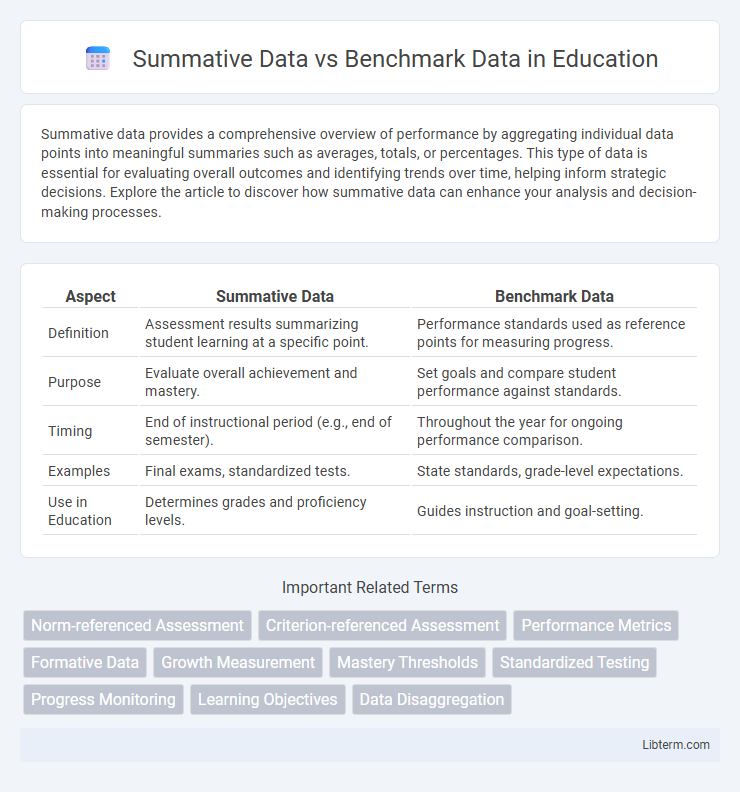Summative data provides a comprehensive overview of performance by aggregating individual data points into meaningful summaries such as averages, totals, or percentages. This type of data is essential for evaluating overall outcomes and identifying trends over time, helping inform strategic decisions. Explore the article to discover how summative data can enhance your analysis and decision-making processes.
Table of Comparison
| Aspect | Summative Data | Benchmark Data |
|---|---|---|
| Definition | Assessment results summarizing student learning at a specific point. | Performance standards used as reference points for measuring progress. |
| Purpose | Evaluate overall achievement and mastery. | Set goals and compare student performance against standards. |
| Timing | End of instructional period (e.g., end of semester). | Throughout the year for ongoing performance comparison. |
| Examples | Final exams, standardized tests. | State standards, grade-level expectations. |
| Use in Education | Determines grades and proficiency levels. | Guides instruction and goal-setting. |
Introduction to Summative and Benchmark Data
Summative data assesses overall student learning by evaluating performance at the end of instructional periods, often through final exams or standardized tests. Benchmark data provides periodic snapshots of student progress throughout the academic year, enabling educators to identify strengths and gaps relative to grade-level standards. Both data types support informed instructional decisions, with summative data measuring mastery and benchmark data informing timely interventions.
Defining Summative Data
Summative data refers to the evaluation information collected at the end of an instructional period to assess overall student learning, skill acquisition, and academic achievement against predefined standards. It serves as a comprehensive measure of educational outcomes, often used for final grades, accountability, and program effectiveness. Summative assessments typically include standardized tests, final exams, and end-of-term projects, providing a snapshot of student performance after instruction completion.
Understanding Benchmark Data
Benchmark data serves as a reference point that allows educators and organizations to measure individual or group performance against established norms or standards. It helps identify strengths and weaknesses by comparing current results with expected outcomes or district, state, or national averages. This data supports informed decision-making and targeted interventions by highlighting gaps and progress over time.
Key Differences Between Summative and Benchmark Data
Summative data evaluates overall student learning outcomes at the end of an instructional period, providing a comprehensive assessment of mastery, while benchmark data measures student progress at regular intervals to guide instructional adjustments. Summative assessments typically include final exams, standardized tests, or end-of-unit projects, whereas benchmark assessments are shorter, formative-like tests aligned with curriculum standards. The key difference lies in their purpose: summative data informs about cumulative achievement, and benchmark data supports ongoing monitoring and targeted interventions to enhance student learning trajectories.
Purposes and Uses of Summative Data
Summative data primarily serves to evaluate overall student learning, effectiveness of instructional programs, and achievement of educational standards at the end of a designated learning period. It is utilized by educators and administrators to make high-stakes decisions, including grade promotion, curriculum adjustments, and accountability reporting. This data provides a comprehensive snapshot of performance outcomes, guiding policymakers in resource allocation and strategic planning.
Purposes and Uses of Benchmark Data
Benchmark data serves to compare performance against established standards or competitors, providing actionable insights for setting goals and identifying areas of improvement. It helps organizations track progress over time and align strategies with industry best practices, ensuring continuous growth and competitive advantage. By contrast, summative data primarily evaluates overall outcomes after a process or intervention, offering a final measure of effectiveness rather than ongoing diagnostic feedback.
Data Collection Methods for Summative Assessments
Summative data collection methods typically involve standardized tests, final projects, or comprehensive exams designed to evaluate student learning at the end of an instructional period. These methods emphasize accuracy, consistency, and comparability to measure overall achievement against predefined learning objectives. Using structured rubrics, digital assessments, and formal evaluation tools ensures reliable summative data that informs decisions on student progress and curriculum effectiveness.
Data Collection Methods for Benchmark Assessments
Benchmark assessments utilize formative data collection methods such as frequent, curriculum-aligned tests to monitor student progress and inform instruction. These assessments often employ digital platforms and adaptive testing technologies to gather real-time performance data, enabling timely interventions. In contrast, summative data is typically collected through standardized, end-of-term exams that evaluate cumulative knowledge without ongoing monitoring.
Impact on Instruction and Decision Making
Summative data provides a comprehensive evaluation of student learning outcomes, guiding educators in assessing overall program effectiveness and informing long-term curriculum adjustments. Benchmark data offers frequent, progress-monitoring insights that help teachers identify learning gaps early and tailor instruction to meet students' evolving needs. Integrating both data types enhances decision-making by balancing immediate instructional adjustments with strategic educational planning.
Choosing Between Summative and Benchmark Data
Choosing between summative data and benchmark data depends on the instructional goals and assessment timeline. Summative data evaluates overall student learning at the end of an instructional period, providing a comprehensive measure of achievement, while benchmark data offers periodic insights to monitor progress and guide instructional adjustments throughout the school year. Educators prioritize benchmark data for ongoing interventions and summative data for final evaluations and accountability purposes.
Summative Data Infographic

 libterm.com
libterm.com